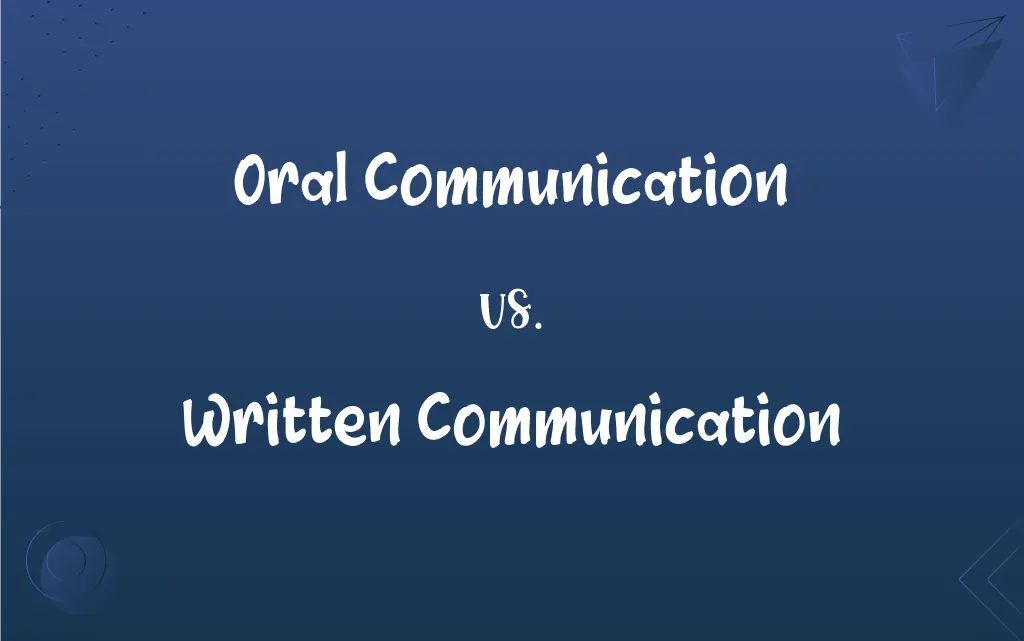Oral Communication vs. Written Communication: What's the Difference?
Edited by Aimie Carlson || By Harlon Moss || Updated on October 7, 2023
Oral communication involves spoken words, while written communication entails expressing thoughts through writing.

Key Differences
Oral communication stands as a foundational pillar in interpersonal interactions, involving the spoken word to convey messages and emotions. Through vocalizations, intonations, and speech patterns, oral communication creates immediate interactions and requires in-the-moment comprehension and response. Written communication, by contrast, embraces the articulation of thoughts, information, and emotions through the written word, often offering the advantage of review and revision before the message is shared.
Despite its immediacy and authenticity, oral communication might sometimes be perceived as less formal and can be subject to misinterpretation due to lack of visual documentation. Written communication, on the other hand, despite its potential for reflection and correction, might sometimes lose the personal touch and emotional resonance that often comes naturally with oral communication, where tone and inflection play pivotal roles in conveying nuances.
In oral communication, direct feedback and real-time adaptation of the message are possible, which might bolster understanding and collaboration during dialogues. Written communication, however, provides a tangible record of exchanges and statements, serving as a reliable reference point for future discussions and could potentially minimize disputes or miscommunications regarding what was communicated.
In terms of accessibility and reach, oral communication often necessitates the immediate presence or auditory access, potentially limiting the audience scope. Written communication, contrarily, offers broader dissemination possibilities, reaching larger and geographically scattered audiences through various mediums like emails, letters, and social media, providing a wide and enduring reach.
Through technological advancements, oral communication has transcended traditional limitations, now enabling global conversations via digital platforms. Simultaneously, written communication has evolved, embracing informal adaptations (like texting) that mirror oral communication's immediacy, thereby blurring the traditional boundaries between the two communication forms.
ADVERTISEMENT
Comparison Chart
Medium of Expression
Spoken words and sounds.
Written or typed text.
Immediate Feedback
Possible and common.
Limited and often delayed.
Documentation
Typically not automatically documented.
Provides a tangible record.
Formality
Can be formal or informal, often seen as less formal.
Can be formal or informal, often perceived as formal.
Reach and Accessibility
May require presence or auditory access.
Can be accessed anytime and potentially anywhere.
ADVERTISEMENT
Oral Communication and Written Communication Definitions
Oral Communication
Oral communication utilizes vocal expressions to transmit information.
His oral communication skills were evident during the persuasive presentation.
Written Communication
Written communication can be executed in various formats, like letters, emails, or reports.
His written communication, particularly in reports, was always thorough and detail-oriented.
Oral Communication
Oral communication entails conveying messages through spoken language.
During the meeting, oral communication was encouraged to foster a collaborative environment.
Written Communication
Written communication provides a tangible or visible record of correspondence between parties.
Her written communication in the email clarified the new procedures effectively.
Oral Communication
Oral communication often relies on tone and intonation to convey emotions or emphasis.
Her expertise in oral communication was clear through her ability to infuse empathy and authority into her speech.
Written Communication
Written communication often requires attention to grammar, structure, and tone to convey messages accurately.
The clarity of written communication in the contract eliminated any potential ambiguities.
Oral Communication
Oral communication involves verbal interactions between individuals or groups.
Effective oral communication was crucial for resolving the conflict between team members.
Written Communication
Written communication enables information dissemination across time and space.
Written communication via newsletters helps keep remote employees informed of company updates.
Oral Communication
Oral communication can be formal or informal, facilitating various social and professional interactions.
The manager’s oral communication during the informal check-in was both friendly and constructive.
Written Communication
Written communication encompasses expressing thoughts, ideas, or information through writing.
The company prioritizes clear and concise written communication in its policy documents.
FAQs
How is feedback received in oral communication?
In oral communication, feedback is often immediate and direct, enabling real-time responses.
Can written communication be informal?
Yes, written communication can take on informal tones, especially in texts or casual messages.
Does oral communication require listening skills?
Absolutely, effective oral communication requires both proficient speaking and attentive listening skills.
Can written communication be interactive?
While generally not as interactive as oral communication, written exchanges like emails or chats can facilitate back-and-forth communication.
Can oral communication be recorded?
Yes, oral communication can be recorded for documentation, though ethical and legal considerations must be observed.
Is oral communication informal?
Oral communication can be both informal and formal, depending on the context and participants.
What's a key challenge in written communication?
Maintaining the reader’s engagement and ensuring clear comprehension can be challenging in written communication.
Is written communication asynchronous?
Generally, yes. Written communication does not require simultaneous engagement from all parties.
Can oral communication be formalized?
Yes, oral communication can be formal, e.g., structured speeches or official verbal announcements.
How is tone managed in written communication?
In written communication, tone is conveyed through word choice, punctuation, and syntax.
What are barriers to effective oral communication?
Barriers may include language differences, noise, distractions, or poor listening skills.
What skills enhance oral communication?
Skills like clarity, conciseness, coherence, and proper pronunciation enhance oral communication.
What is oral communication?
Oral communication involves expressing thoughts and information through spoken words.
Why is grammar crucial in written communication?
Grammar ensures clarity and professionalism in written communication, preventing misunderstandings.
How does technology influence oral communication?
Technology facilitates oral communication across distances through phones, video calls, and voice messaging.
How has technology impacted written communication?
Technology has expanded written communication platforms, e.g., emails, chats, and has influenced stylistic and formatting norms.
How does non-verbal communication impact oral communication?
Non-verbal cues, like gestures and facial expressions, enhance or modify oral communication by adding emotional context.
How does written communication support global business?
Written communication enables asynchronous, clear, and documented exchanges across diverse global stakeholders.
How does written communication occur?
Written communication involves conveying messages and information in a written or typed format.
Is written communication more reliable for record-keeping?
Yes, written communication provides a tangible record and is often preferred for documentation.
About Author
Written by
Harlon MossHarlon is a seasoned quality moderator and accomplished content writer for Difference Wiki. An alumnus of the prestigious University of California, he earned his degree in Computer Science. Leveraging his academic background, Harlon brings a meticulous and informed perspective to his work, ensuring content accuracy and excellence.
Edited by
Aimie CarlsonAimie Carlson, holding a master's degree in English literature, is a fervent English language enthusiast. She lends her writing talents to Difference Wiki, a prominent website that specializes in comparisons, offering readers insightful analyses that both captivate and inform.































































